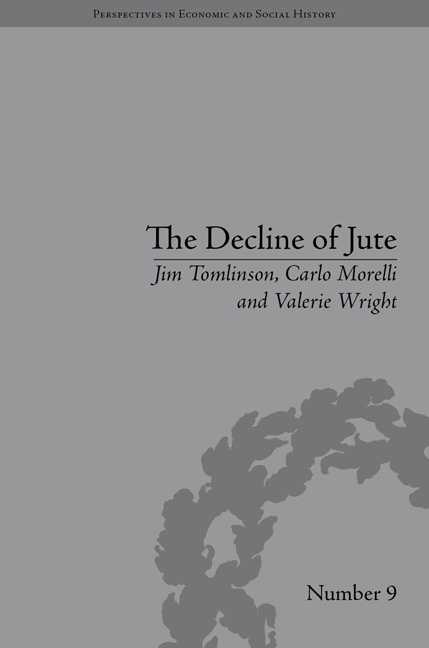Book contents
- Frontmatter
- CONTENTS
- Dedication
- Acknowledgements
- Abbreviations
- List of Figures and Tables
- Introduction
- 1 The Story up to 1939
- 2 De-Globalization and Decline, 1939–99
- 3 The Industry and its Workforce
- 4 Defending the Domestic Industry
- 5 Firms’ Responses to the Decline of the Industry
- 6 Influencing Government
- 7 The Decline of Jute and the Economic Health of Dundee
- Conclusions
- Notes
- Works Cited
- Index
3 - The Industry and its Workforce
- Frontmatter
- CONTENTS
- Dedication
- Acknowledgements
- Abbreviations
- List of Figures and Tables
- Introduction
- 1 The Story up to 1939
- 2 De-Globalization and Decline, 1939–99
- 3 The Industry and its Workforce
- 4 Defending the Domestic Industry
- 5 Firms’ Responses to the Decline of the Industry
- 6 Influencing Government
- 7 The Decline of Jute and the Economic Health of Dundee
- Conclusions
- Notes
- Works Cited
- Index
Summary
The Working Party Report published in 1948 became a key reference point in post-war discussions of the jute industry, and the need for its ‘modernization’. The establishment of this Working Party was one important sign of a major new national emphasis on industrial efficiency which began during the war and was strongly pursued by the Attlee government after 1945. In many respects this shift was a straightforward consequence of wartime Britain moving from a labour surplus economy, suffering mass unemployment, to one in which labour was in short supply, and therefore had to be used more efficiently. While the emphasis on efficiency led to national initiatives on everything from Research and Development to investment to training, at the centre of much of the argument was labour; ‘higher labour productivity’ became a key aim, and in many analyst's and policy-maker's views this was to be achieved by direct action on labour usage and labour effort.
Working parties were set up by the Labour government for a range of industries with a similar remit, which in the case of jute was to:
Examine and inquire into various schemes and suggestions put forward for improvements of organization, production and distribution methods and processes in the jute industry, and to report as to the steps which should be taken in the national interest to strengthen the industry and render it more stable and more capable of meeting competition in the home and foreign markets.
- Type
- Chapter
- Information
- The Decline of JuteManaging Industrial Change, pp. 35 - 64Publisher: Pickering & ChattoFirst published in: 2014



